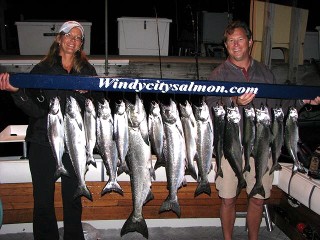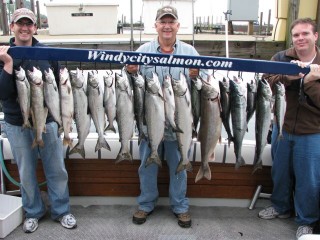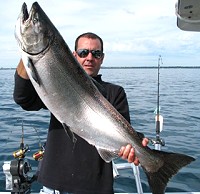| While varying sometimes widely from lake to lake as well as by region in which you fish certain Great Lakes, we can generally classify the fishing season here into three different sub-seasons; Spring, Summer & Fall.
Spring
 |
Spring fishing where I charter in my region at the far south basin of Lake Michigan out of Waukegan, IL will usually begin in April and run through about the middle to the end of June. Farther south where the Indiana shore meets the lake, fishing can begin as early as Feb or March depending on conditions which generally means if the water has begun to warm up enough and if it’s actually safe to be on the water!. This is the time of year where we primarily catch Coho Salmon and many times during this period we catch loads of the them; limits of 20-30 fish sometimes in just an hour or two. The reason why the southern basin of Lake Michigan offers this explosive Coho action are two-fold and both have to do with water temp. It is the farthest south (latitude) of the Lake and since it is shallower, it warms up the fastest. While Salmon & Trout are indeed cold water fish, water temperatures need to rise at least into the low 40’s from the 30’s for these fish to begin their active Spring feeding. Large schools of Coho will be heavily concentrated at the southern basin of the Lake during this time and as water temps rise along the eastern and western beaches and shorelines, the Coho will start to spread northward.
During the Coho run we also tend to catch a fair amount of Brown Trout when fishing in 50 feet of water or shallower. When we find ourselves fishing further offshore for Coho, we may also catch lots of Steelhead (Rainbow Trout) especially because we are running our baits within the top 10 feet of water where Steelhead tend to do most of their feeding. The primary baits we run this time of year are orange/red dodgers/flashers and flies. Crankbaits such as as Hot n tots and Thin Fins will see some time on our lines and catch fish as well but the dodgers and fly setups take the most fish for us this time of year. Most of our baits are also run in the top 10 feet of water on dipsy divers and planer boards such as yellow birds. Spoons on riggers will catch some Coho but are run more for the chance to catch Brown Trout and Chinook as both species are more likely to strike these instead of orange dodgers and flies. The focus of the second installment in this series focuses exclusively on Spring Coho fishing.
Some seasons such as the one we just experienced in 2009, will see us catching fair to good numbers of Coho even well into July. When this situation presents itself, you will want to have at least some Coho-favorable baits in the water. For me this has meant continually running dodgers/flashers and flies but in the larger versions. We catch Coho on spoons as well but flashers & flies take more Coho than any other bait here. When warmer water rises to the surface and colder water descends, larger dodgers and flashers in both red & NON-RED such as white plastic Hot Spot and chrome, white, or yellow Luhr Jensen metal dodgers with larger flies on downriggers and dispies will continually catch more Coho than most other baits.
Therefore your June and early July setups will need to incorporate ‘hybrid’ spreads of Coho baits and Chinook baits as well as Lake Trout and Rainbow Trout baits. In many cases, there are baits that will catch all species at the same time. This is especially true with larger flashers and flies for Coho, Chinook as well as Lake Trout.. However, as the species of fish that are being caught dictates, you may choose to concentrate your spread in a particular direction.
For example, we may encounter large schools of Rainbow Trout that are concentrated near the surface during this time of year. If you have already caught a few Rainbows and/or have heard that Rainbows are being caught while other species are being more stubborn, you can shift your spread of lines/baits to focus in on what Rainbows like to strike. In my region, this means leaving at least a few red flashers/flies out up top on planer boards still as they will take both Coho and Rainbows but also running some standard size spoons up top in red/orange while perhaps experimenting with some bright greens and blues as well. Body baits such as J-Plugs, Rebel jointed Fastracs, and similar baits should also be considered as well. During the Spring and Summer of 2009, I ran standard Michigan Stingers in their Mongoose pattern on one or both of my outside yellow birds with one or two 5/8 ounce keel sinkers about 7 feet in front of them and caught every species of fish on that setup but it took more Rainbow and Brown Trout than other species when they were biting and other species weren’t.
In other words, before Chinook arrive in full force during sometime in July, the mixed bags of fish that make up our catch during the Spring/Summer transition will be maximized by being flexible with the baits you run and delivery devices you run them on. Let the fish tell you what they want and then orient your spread as such.
Summer
Summer fishing is typically characterized by fishing primarily for Chinook Salmon. While Chinook are available and will be caught in the Spring, loosely packed schools of Chinook of all ages will generally roam the lake together but eventually orient nearer and nearer to the harbor or river of their planting or birth to spawn. Spawning 4-year old Chinook – as we call them – are hearing this call of nature and will begin ‘staging’ from either very close to up to 12-15 miles off these harbors or streams.
Other species will be caught during this period as well but Chinook are our primary target and therefore our baits and delivery devices are oriented towards them. This means our spreads are usually made up of 3 or 4 downriggers where at least of two of them often contain a segment of 2 or 3 colors of leadcore line that will run between the downrigger weight and bait. In some regions this is called a SWR (secret weapon rig) and the primary purpose of this setup is to run the bait – usually a ‘clean’ spoon – well behind the downrigger weight but also to have that spoon trail 8-12 feet below the weight as well (from the weight of the leadcore line). I run a segment of 17-20lb test flourocarbon line from the end of the leadcore to the spoon of about 20-25 feet.
I have had the most success running the 2 or 3 color leadcores off my boom or side downriggers while keeping the middle downrigger free for a either another spoon on regular monofilament line or for a flasher/dodger and fly. Several full leadcore (7-15 or more colors) and full copper line (200′-400′ feet) setups will also be run straight off the back as well as off of larger planer boards such as Walleye Boards. Super or braid line (such as Power Pro) is run on dipsy diver applications as well as wireline as well. As the sun rises the earliest at this time of year, we have found that the super-early morning bite has proved beneficial and this means leaving the harbor at 4 or 5 in the morning and running a spread of glow spoons such as Moonshine spoons. This wasn’t always the case in the past but has become nearly the rule these days. My general theory for this is that Chinook are the top predator in the lake and as such must expend energy to feed. The cleaner water that is now in place due to zebra mussels means that alewives might be able to have an easier time seeing and evading approaching Chinook. In that regard, pre-dawn and dawn sunlight affords chinook the ‘cover’ they actively utilize to ambush prey. And further, often times Chinook will feed on a far lesser scale by the time the sun is higher in the sky and into the afternoon hours. This has a somewhat lesser effect on the other species but the dusk bight can often be as good as the morning bite. However, we have also encountered days where the mornings are slow but the afternoon is good. So while the mornings aren’t always better, the usually are. We find that when the afternoons are better than the morning, it seems to have more to due with to high and low air pressure systems moving through the area.
Most Chinook Salmon are caught on a mix of spoons and flashers/dodgers and flies. Depending on the region you are in, some setups will catch more than others and in my region, spoons generally take more Chinook than flashers and flies. Other regions may be just the opposite. Chinook are probably the most sensitive fish to how you deliver your baits as well as sensitivity to boat noise, downrigger ball and dipsy diver visibility/turbulence, and downrigger cable and wireline visibility turbulence, therefore this means long leads off of downriggers especially for spoons. Leadcore and copper produce this ‘long lead’ on their own as these baits will be running 200-400 feet behind and off to the side of the boat and these applications are generally referred to as ‘stealth’. Dodgers/flashers and flies are less dictated by this principle as these baits in my opinion, trigger a different strike mechanism in the fish but long leads with these baits can also work as well. Glow in the dark spoons have become favorites of anglers in my and many other regions for Chinook. This is especially true for the early morning bite but many times glow baits will continually catch fish well into the daytime and the afternoon. Many spoon manufacturers make glow varieties but Moonshine spoons have worked the best for us and in fact probably caught more Chinook for us last year overall than any other bait whether it be spoons or dodger/flasher and fly.
As with any species and baits, pick a few rods to experiment bait changes on while leaving the tried and true baits on the others. There will be a lot of times that you will find a bait that fish will far prefer over others and that one bait that you may have put on by trial and error will mean the difference between few fish and a good catch. This principle holds far truer when Chinook fishing in the summer than at most other times. However, be mindful of what baits you are changing and leaving in the spread as sometimes fish will be attracted to one bait but will strike another. This latter point can be best made by saying that if one bait has been catching most of your fish and you go to change the bait on the downrigger next to it to the same bait (which is the natural inclination) and all of a sudden you run dry of the fish, put the original bait that was not catching fish back on because it was likely drawing fish in to strike your other lures. It is in this regard again that Chinook can be perhaps the most finicky when it comes to presentation, color, and bait selection. The principle of ‘less is more’ is often in force when fishing for Chinook too. What this means is if you are running four downriggers and not catching fish, try running three instead. I have had plenty of success with four riggers but I seem to consistently produce more fish when fishing for Chinook when I am running three. In that regard I will more often than not, begin and end the charter running three riggers while never even giving a thought to running four. Try running longer leads off of your downriggers as well. If you are running dipsy divers off to the sides and not catching fish on those rods or your riggers but your leadcore and coppers are working, try pulling your dipsies entirely and running a downrigger and leadcore/copper only spread. Divers put off a large amount of turbulence and that may effect how fish are attracted or unattracted to your other spread of lures. This holds more true as the sun is higher in the sky. Unless the state of the water (waves) make it difficult to run dipsies without tangles, I will usually deploy dipsies with clean spoons or dodger/flasher and flies at the outset of nearly every morning charter but will sometimes have them back in the boat if the bite begins to taper off as the sun gets higher.
Fall
 |
As the large spawner Chinook find their way into shallower water at the end of the summer and into fall and become more difficult to catch, the offshore action can and will often remain good for non-spawner Chinook as well as Lake and Rainbow Trout. This time of year can generally classified as the Fall season while also keeping in mind that the inshore action for spawning Chinook can also light up if you get a wind regime that blows the warm surface water out and cold water comes in underneath. Spawning Chinook near shore will feed far less or not at all but when there is cold water near shore, even if they are not feeding, they will be far more likely to strike spoons and body baits out of aggression than if there is warm water in place. The primary principle here is that these spawning Chinook are no longer feeding and are striking out of aggressive impulse. That aggressive impulse becomes much more dulled down when they are in warm water. So in that regard you have two fisheries to choose from in the fall. However if there is warm water inshore even if the fish are there, they will be difficult to catch and that is especially true during daylight. Most captains will choose the offshore fishery in this scenario and in that regard the offshore fishery is nearly identical to the summer fishery except we may be fishing deeper both in how far out we are as well as where our baits are but this will be dictated by at what depth we can find cold water. This fishery is much like the summer setup in both presentation as well as bait selection, where 5-12 color leadcores (or even 15 or 20 colors) and copper lines with spoons or plugs will produce all species. Downriggers in a summer-style setup will catch mostly Chinook and Lake Trout. Lake Trout are also beginning their spawning season as well near offshore structure reefs and therefore your catches of this species may tilt in that favor on some days. This is usually the time of year to catch some monster Lake Trout too. For the most part, Lake Trout can be caught on the same spoons or dodgers and flies that you run for salmon. However, Lake Trout usually like a lower trolling speed than salmon (and Rainbow Trout) do. Therefore, like Spring-Summer transition, let the fish dictate what you should orient your baits and speed to. If Salmon are being stubborn and some Lake Trout are being caught then slow your trolling speed down if you would like more Lake Trout action and perhaps orient a few more of your baits to more dodgers and flies as well as dodgers with trailing spoons and spin and glos with fly tails. There are plenty of other “exotic” Lake Trout baits available such as ‘cowbells’ or ‘six-packs’ you may wish to try as well but in our region, we will usually do just fine on spoons, dodgers and flies or spin and glos.
If conditions are setting up right for active spawning chinook near shore (meaning cold water is present) then you will be fishing with a mix of spoons and body baits such as rebels/rapalas and J-plugs off of downriggers, dipsy divers, and yellow birds while also towing shorter segments of leadcore such as 3-5-7 colors off larger planer boards. Be mindful of the shallower depth so you don’t hang the bottom as well as pick up weeds. This fishery may also yield a fair amount of Brown Trout as they will spend nearly all their life in far more shallow water and sometimes some Rainbow Trout too which have made their way in from offshore to feed on salmon eggs.
As an overview article, there is a large amount of information to digest here but there is also a lot of both basic and advanced information that has been left out such as trolling speed and direction, specific lure selection, water temperature etc. However my purpose in writing it was to provide the meat and potatoes of Lake Michigan Salmon & Trout fishing to get started along with a few additional tips to improve your catch. In other words, many many pages could be spent writing on the basics of salmon & trout rigging but we chose to dive right in and assume a more basic skill level right off the bat!
 |
Captain Rick Bentley is a full-time U.S. Coast Guard Licensed charter boat Captain out of the Port of Waukegan in Illinois and is owner/operator of the vessel *Independence* and *Windycitysalmon.com*. He is one of the younger Captains in the harbor and on the Lake, originally getting his start in the industry as a Deckhand/First Mate. For more information or to read Capt Rick’s fishing reports please visit WindyCitySalmon.Com  |